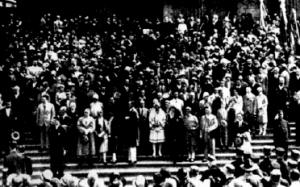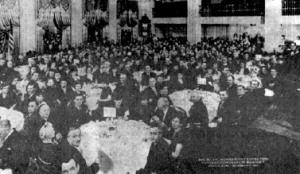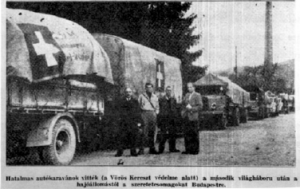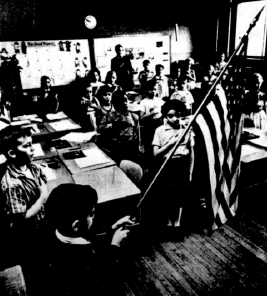Section II: Hungarians in America
The World Wars and Their Impact on Hungarian-Americans (1920-1970)
A.The Inter-War Years
The Emergency Quota Act of 1921 seriously limited the number of Hungarian immigrants bound for the United States. The Quota Act curtailed immigration in any year to three percent of the number of the nationality in the United States, according to the 1910 census. No more than 5,747 Hungarians were allowed to immigrate per year, as designated by this new law. This represented a substantial reduction in comparison to the pre-war annual average. In 1924 a new act was passed which further curtailed immigration to a two percent quota. This allowed only 869 Magyars to enter the United States annually.
This restrictionism exerted a profound effect upon Hungarian-American communities, which became increasingly isolated from the mother country. The lack of new immigrants brought about the following reactions: in the smaller communities the rate of assimilation was augmented; there was little a small community could do to withstand the pressure to Americanize. The larger communities became introverted, their institutions and organizations concentrated on maintaining Hungarian culture and language. The communities remained isolated from the homeland for over twenty-five years, until new immigration laws were finally enacted after the Second World War.
According to a report on immigration and naturalization, published by the U.S. Department of Justice, between 1921 and 1940, 38,541 Hungarians entered this country. The inter-war immigrants came out of various reasons: there were political emigrés who left Hungary following the dissolution of the socialist government of 1918 or the communist rule of 1919. There were those who emigrated because of the miserable economic situation. Still others emigrated from the partitioned territories of Hungary, not wanting to live as part of a minority under foreign rule.
Generally, these immigrants were educated and from the middle class; most were professionals, businessmen or skilled workers. Because of the relatively small number of immigrants who came over a span of twenty years, the inter-war arrivals had little impact on existing Hungarian communities.
Hungarian-American communities were significantly affected by two historical events: the quota system which literally isolated them from the homeland and the Treaty of Trianon, dictated to Hungary following World War I. The Treaty of Trianon united Hungarian-Americans in opposition to the dismemberment of Hungary’s historical territories and to the injustices inflicted upon fellow countrymen living in the partitioned areas.
Hungarians in America could belong to different religions and classes could differ in world outlook, but there was one issue on which nearly all ex-Hungarians in the United States agreed after World War I: the question of Hungary’s boundaries. Even the least nationalistic Hungarians agreed that the frontiers of Hungary were not just.[1]
In 1923 the New York-based Hungarian-American newspaper, Amerikai Magyar Népszava (American Hungarian People’s Voice), led a campaign to aid the Hungarian refugees who had fled the occupied areas of the mother country. As a result of the campaign, twenty-six carloads of gift packages were collected and sent to Hungary by communities in New York and New Jersey.
In a more dramatic effort to bring attention to the injustices of Trianon, Hungarian-Americans, in conjunction with the Hungarian World Alliance, sponsored a transatlantic flight in 1930, on the tenth anniversary of the treaty. The historic trip took place on July 15, 1930 from Harbour Grace, Newfoundland to Budapest on a non-stop flight of twenty-six hours. The plane was called Justice for Hungary and was piloted by George Endresz and Alexander Magyar. The flight occurred in the days of the first transatlantic flights and was the first plane crossing the ocean which had radio contact with both the starting and landing aerodromes.

In 1936 Szabadság (Liberty), a Cleveland-based daily launched a campaign to protest the injustices of the Treaty of Trianon. Through the efforts of the newspaper, one million signatures were collected demanding the revision of the treaty. The signatures were given to President Roosevelt on March 4, 1936.
Attempts to unite the over two hundred Hungarian-American organizations had been for the most part unsuccessful. The American Hungarian Federation was founded in Cleveland in 1906 with the expressed purpose of uniting and protecting Hungarians living in the United States. In the years which followed, however, the federation diminished in importance because of lack of support and interest.
The American Hungarian Federation was reorganized at a grand assembly of all Hungarian organizations held on May 29, 1929 in Buffalo, New York. The federation obtained full support and was recognized by the United States government as the official spokesman of Hungarian-Americans. One of the American Hungarian Federation’s purposes was to coordinate efforts for the revision of the Treaty of Trianon and bring to the attention of politicians and lawmakers the importance of such a revision.
The Hungarian World Alliance was formed in Budapest to unify and coordinate worldwide efforts to revise the treaty. Members included representatives of Hungarian communities in many parts of the world and friends of Hungary from foreign countries. The first International Congress of Hungarians was held in Hungary in August 1929. From the United States alone, 125 delegates participated, representing fifty-two Hungarian-American organizations. The Second International Congress, held in 1938, was attended by 283 Hungarian-American delegates.
The tragic consequences of Hungary’s participation in the war influenced Hungarian-Americans to an even greater extent: suddenly the maintenance of their language and culture became of primary importance.
Parochial elementary schools, which taught all or part of their curriculum in Hungarian, were built by the communities next to the established churches. The number of full day Hungarian-American parochial schools expanded from four to some twenty in less than two decades.[2] One school, the elementary school of St. Elizabeth of Hungary Roman Catholic Church in Cleveland, had an enrollment of over 1,000 pupils in the 1900s. According to one author, “…in the twenties and early thirties, virtually every Hungarian-American child went to a Hungarian language school, except in the rural and mining communities where the more closely knit family life served the same language maintenance function.”[3] Second generation Hungarian-Americans were for the most part perfectly bilingual and spoke Hungarian more purely than their parents whose formal education was usually limited.
The Hungarian-American community attained cultural as well as educational refinement. Choirs, amateur dramatic groups and book collections were initiated and maintained by organizations. Public libraries developed Hungarian collections in response to the increased interest. Theatre performances were encouraged and supported. One group, “consisting of twenty-five professional actors, an orchestra and a large managerial staff, regularly toured the larger Hungarian communities between New York and Chicago.”(insert footnote here)60
This age of unprecendented cultural development was halted by the Great Depression. The 1930s brought widespread unemployment which in turn made community support of organizations and cultural institutions virtually impossible. Hungarian-Americans, as all Americans, were then primarily concerned with combatting the economic hardships of the times.
Although the inter-war immigrants made little impact on Hungarian-American communities, there were many talented Hungarians who arrived at this time who made great contributions to American life in the social, cultural and intellectual fields. Many of these immigrants were Hungarian Jews. All were highly talented individuals who were unable to realize their full potential in their homeland. The contributions of only a few in the fields of the theatre, cinema, music and science are examined.
It was known as the “Hungarian invasion of American theater.” Between 1908 and 1940, in New York City alone, adaptations and productions of fifty-three Hungarian plays written by twenty-one authors were presented.[4] The plays of Ferenc Molnár, world-renowned playwright, totalled 2,148 first run performances.[5] His most famous works included: The Devil, Liliom, The Guardsman, The Swan, and translated from Hungarian, The Prisoners, Eva and The Boys of Paul Street. Architect Joseph Babolnay designed some of the most up-to-date theaters in America. Babolnay also introduced stage television on Broadway in 1931.
Most of the founders of the American motion picture industry were Hungarian-born Jews. Adolph Zukor was president and founder of Paramount Pictures. William Fox established the Fox Film Producing Company and the Fox Film Theater Trust, the latter encompassed some 900 theaters. Some of the Hungarian-born directors and producers who created films during the 1920s, 1930s and 1940s were: George Cukor, Michael Curtiz (Kertész), the Korda brothers-Alexander, Vince and Zoltán, Joseph Pasternak and Ivan Tors (Törzs). Actors and actresses included: Vilma Bánky (sweetheart of the silent screen and early talkies), Zsa Zsa Gábor, Eva Gábor, Mitzi Gaynor, Leslie Howard (stage name of Árpád Steiner), Ernie Kovács, Peter Lorre (stage name of László Loewenstein) and Béla Lugosi. The acting career of Paul Lukas (Lukács) spanned forty years; he played parts in seventy-seven films. Lukas received an Academy Award for his performance in Watch on the Rhine. Another distinguished actor, Szoeke Szakáll, acted in thirty-nine film roles between 1940 and 1951.[6]
Many major American cities have offered the directorship of their symphony orchestras to Hungarian-born conductors. Fritz (Frigyes) Reiner was conductor of the Cincinnati Symphonic Orchestra and the Chicago Symphony Orchestra, each for over ten years. George Széll was with the Metropolitan Opera House in the early 1940s before becoming permanent conductor of the Cleveland Orchestra in 1946. Eugene Ormándy was a child prodigy who came to the United States in 1921. He has been conductor of the Philadelphia Orchestra since 1938. Ormándy was renowned for conducting all scores from memory. Antal Doráti made his American debut in 1937 with the National Symphony in Washington, D.C. In recent years he was made conductor of the Detroit Symphony Orchestra. Sir Georg Solti has been musical director of the Chicago Symphony Orchestra since the early 1970s.
In the area of science, John von Neumann, one of the greatest mathematicians of our time, known as the “father of the computer,” was a native of Hungary. Neumann came to the United States in 1931 as a lecturer. In 1945 he was appointed director of the Electronic Computer Project at Princeton University. Neumann’s book, Mathematical Foundations of Quantum Mechanics, laid the groundwork for the mathematical applications of the computer and is still used as an invaluable reference. Hungarian-born physicists Edward Teller, Leo Szilárd and Eugene P. Wigner were among the five scientists requested to work on the development of the atom bomb (The Manhattan Project).
Eugene Wigner was awarded the Nobel Prize for Physics in 1963 for research in the mechanics and interaction of protons and neutrons in the atomic nucleus. Another Hungarian-American scientist, Dennis Gábor, won the Nobel Prize for Physics in 1971 for the invention and development of holography. Holography is a system of lenseless three dimensional photography.
B. The Second World War and the Displaced Persons
Hungarian-Americans were involved more extensively in the war effort during the Second World War than during the First World War. The first generation had resided in this country for several decades and most were citizens and property owners. Thousands of second generation Hungarian-Americans reached adulthood during the inter-war period. For these youths, America was the only homeland they knew; they were both eager and proud to serve in the armed forces of the United States.
According to estimates, 50,000 Hungarian-Americans served in the military forces during the Second World War.[7] In Cleveland alone, 1,300 enlisted during the first six months of United States involvement. Szabadság(Liberty) commemorated the Hungarian-American war dead by printing their name, rank and state of origin in a separate column on the front page of each issue. On the basis of this documentation alone, an average of 150 Hungarians died each month in 1945 while serving in the military forces of the United States. This amounts to a total of 1,800 lives lost throughout the entire year. By all calculations, however, this is a conservative estimate.
National organizations, as well as countless local ones lent assistance in every way possible. The Verhovay Insurance Association and the American Hungarian Federation purchased ambulances for the American Red Cross. The purchase of Defense Bonds was tremendous.


One organization, the Cleveland chapter of the King St. Stephen Catholic Hungarian Insurance Society, purchased $71,000. worth of U.S. Defense Bonds.[8]
Concerted efforts were made to represent the interests of the Hungarian people. Hungarian-Americans realized only too well that the location of their homeland virtually negated any chance of non-alliance during the war. The American Hungarian Federation sent a declaration to the president before the United States entered the war on January 7, 1941.[9] The purpose of the memorandum was to announce a movement for the preservation of an independent and free Hungary.
The American Hungarian Federation repeatedly submitted memoranda to the president and the secretary of state during and after the war years. By 1949, ten of them had been submitted in an effort to safeguard the interests of their homeland. The federation was equally opposed to German nazism and Russian communism.[10] It attempted, through the various contacts with the State Department, to represent the Hungarian people, who, in their opinion, were too overshadowed by both to maintain any semblance of neutrality.
In 1945 Hungarian-Americans organized large-scale relief programs to help alleviate the sufferings of their countrymen in war-ravaged Hungary. The American Hungarian Relief Program, under the auspices of the American Hungarian Federation, collected and sent $1,216,167. in clothing, medicine, foodstuffs and money.[11] In all, 200,000 care packages were sent by countless local and national groups. The greatest benefactors of the movement were: Mrs. László Széchényi (née Gladys Vanderbilt), Lajos Szánthó, president of the Virginia Kentucky Tobacco Company and Daniel Szantay, president of the Santay Corporation. Total estimated costs of the relief program exceeded three million dollars.
Over 26,000 Hungarians were admitted to the United States under the Displaced Persons Act of 1948 and the Refugee Relief Act of 1953.[12] Generally, these refugees were educated and from the urban areas of Hungary. Their political views and background were considerably different from those who had come thirty or forty years earlier in search of economic betterment and opportunities.
The newcomers were disadvantaged from the start. In order to immigrate they had to obtain a “Home and Job Assurance.” This was a written guarantee, on the part of a U.S. citizen, that the immigrant would have a place to stay and employment in the United States. Since the majority of D.P.s had no relatives or friends among the Hungarian “old-timers,” obtaining these assurances happened largely by chance. Church groups and other organizations lent some of the much needed assistance in the resettlement of these new immigrants.
The post-war immigrants obtained work as factory hands, janitors and manual laborers until they could learn English and improve their positions. The adjustment proved to be exceedingly difficult for the older immigrants who were former journalists, educators, lawyers, military officers and elected officials. Often these unfortunate individuals spent the rest of their lives working in a factory, hoping to work long enough to at least obtain a minimum social security after retirement.
The D.P.s left their homeland because of political and ideological beliefs, they intended to return to Hungary when the Russians left, and in these respects they were “emigrés.” Their writings reflected their strong anti-communist sentiments and opposition to the Russian take-over and occupation of Hungary. This post-world war wave produced more writers and published more books than any other wave of Hungarian immigrants (including the 1956 refugees).[13]
The post-war Hungarians were particularly successful at maintaining and promoting their Hungarian heritage. They founded university extension programs and lecture series. They instilled a strong sense of cultural identity in their offspring through Saturday language school and summer school programs. They rendered new life to the gradually diminishing Hungarian communities by forming new and reviving old organizations. Many of the new organizations formed were cultural, educational, and/or political in nature. Several were formed to maintain traditions upheld in Hungary, particularly those traditions discontinued since the communist take-over. Some of these included the Hungarian Veterans and the Veteran Gendarmes. By far the most successful organization to be transplanted and reorganized in the United States was the Hungarian Scouts’ Association.
The Hungarian Scout Association has been the most successful organization in preserving the language and culture of the second generation, the children of the post-war immigrants.[14] Hungarian scouting offered a non-conventional approach to learning Hungarian history, literature, geography and folk art. It appealed to hundreds of second generation Hungarians seeking to identify meaningful experiences with their heritage. Through scouting, Hungarian-American youths meet others with similar backgrounds and bicultural experiences. In the 1970s nearly 6,000 scouts registered in eighty-four troops were reported in twelve countries worldwide.
Founded in 1910, the Hungarian Scouting Movement quickly gained international respect and acclaim. Gödöllo, Hungary was chosen as the site of the fourth World Jamboree in 1933. Following the Second World War, the Hungarian Scout Association was dissolved by the new communist government. Facilities owned by the association: parks, houses, air and water training bases were confiscated. The Hungarian Scout Association in Exile was founded and activities were renewed in Western Europe.
Hungarian D.P. immigrants in Germany, Austria and Italy began the reorganizational work in 1946. By 1949, 3,118 boy and girl scouts (united in one association at this time) were registered in forty-one troops throughout Western Europe. In the early 1950s the headquarters of the association was transferred from Europe to Garfield, New Jersey. Organizational efforts also expanded to South America and Australia. The Hungarian Revolution in 1956 brought even more young people to the ranks of the movement.
The various programs offered by Hungarian scouting have continued to attract young men and women. Leadership training camps, which are held annually on four continents, maintain high standards and require serious effort on the part of the candidate seeking a leadership role or an advanced leadership role in the organization. Over 6,700 scout leaders have earned their ranks through these leadership training programs. Members of the association have gained friendship and worldwide experience from ongoing exchange programs within the association. Leaders and scouts alike from Europe, North America, South America and Australia travel and visit troops on other continents. These visiting scouts assist and present lectures at summer camps and training courses.
The Hungarian Scout Association operates and maintains nearly half of all the Hungarian language schools in the United States.[15] In addition, the association publishes numerous educational texts and teaching aids as well as a Hungarian scout magazine and other materials relating to scouting. One particularly noteworthy organizer and official of the association was Gábor Bodnár, who has served as executive president of the association for nearly two decades. As a young man, Bodnár was already a member of the Grand Council of the association in Hungary. Since 1945 Bodnár has worked tirelessly in building the Hungarian scouting movement through initiating and coordinating organizational efforts worldwide.
C. The Refugees of the Hungarian Revolution

These refugees were markedly different from any previous wave of Hungarian immigrants. First of all, they were the youngest group; many were single. The majority had some kind of technical training and their skills were readily employed by American industry. Psychologically, immigration made lasting impressions on these refugees. For eleven years they experienced life under economic depravity and political terror. As a direct consequence, their interests in America were more materialistic and self-centered; cultural or group attachments were much weaker when compared to those of previous waves of immigrants. They adjusted with greater ease, learned English in a short while, with many of them marrying English-speaking mates. Their contributions to their adopted homeland were numerous.
Some new organizations were founded by the 1956 refugees. The largest, the World Federation of Hungarian Freedom Fighters, was founded in 1957 to propagate the ideals of the revolution in the Western world. Membership was reported at 10,000 in the 1970s. Representatives meet at world congresses held regularly every two or three years. Monuments commemorating the revolution were erected in three cities: Toronto (Canada), Los Angeles (California) and South Norwalk (Connecticut). The erection of these monuments was initiated and carried to fruition largely by members of the federation.
- Mark I. Major, American Hungarian Relations 1918-1944 (Astor, Fla.: (Danubian Press). , 1974), p. 133. ↵
- Joshua Fishman, op. cit. , p. 9. ↵
- Ibid. , p. 10. ↵
- Francis S. Wagner, Hungarian Contributions to World Civilization (Center Square, Pa.: (Alpha Publications). , 1977), p. 162. ↵
- Ibid. , p. 162. ↵
- Ibid. , p. 194. ↵
- Joseph Szeplaki, op. cit. , p. 30. ↵
- Szabadság, 28 January 1942. ↵
- John Korosfoy, Hungarians in America (Cleveland: (Szabadság). , 1941), p. 17. ↵
- "A Nacizmust és a Kommonizmust Egyformán Elítéli as A.M. Sz.," Amerikai Magyarság, February 1950. ↵
- "Az American Hungarian Relief, Inc. Eddigi Munkája," Golden Jubilee Album (New York: (American Hungarian People's Voice). , 1950), p. 96. ↵
- Joseph Széplaki, op. cit., p. 131. ↵
- Joshua Fishman, op. cit. , p. 36. ↵
- Ibid. , pp. 18-19. ↵
- Gábor Bodnár, "A Kulföldi Magyar Oktatás 1974-ben" (Garfield, N.J.: (Hungarian Scouts Association). , 1974). ↵
- Alexander S. Weinstock, Acculturation and Occupation: A Study of the 1956 Hungarian Refugees in the United States(The Hague: (Research Group for European Migration Problems). , 1969), pp. 41-2. ↵
